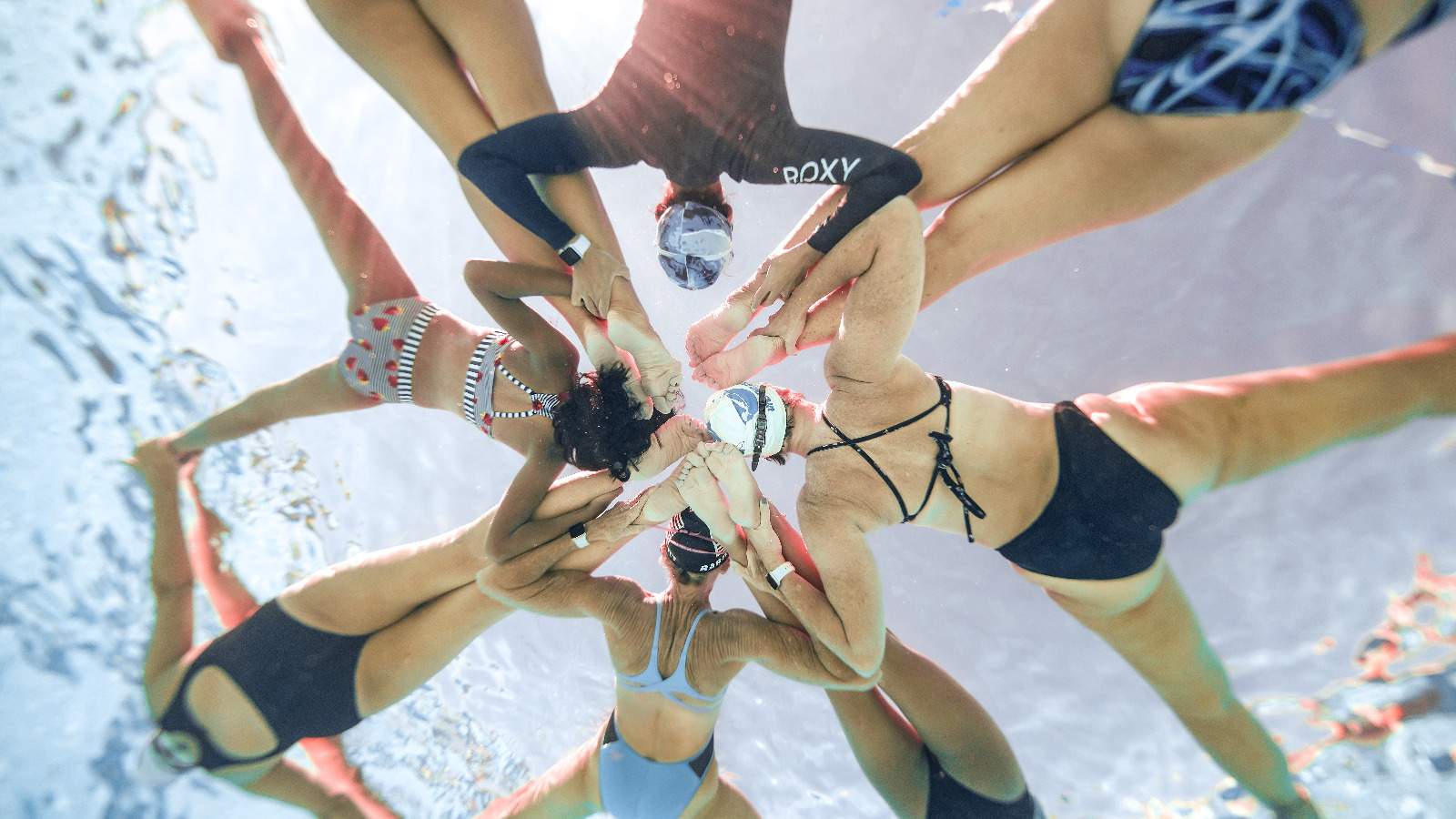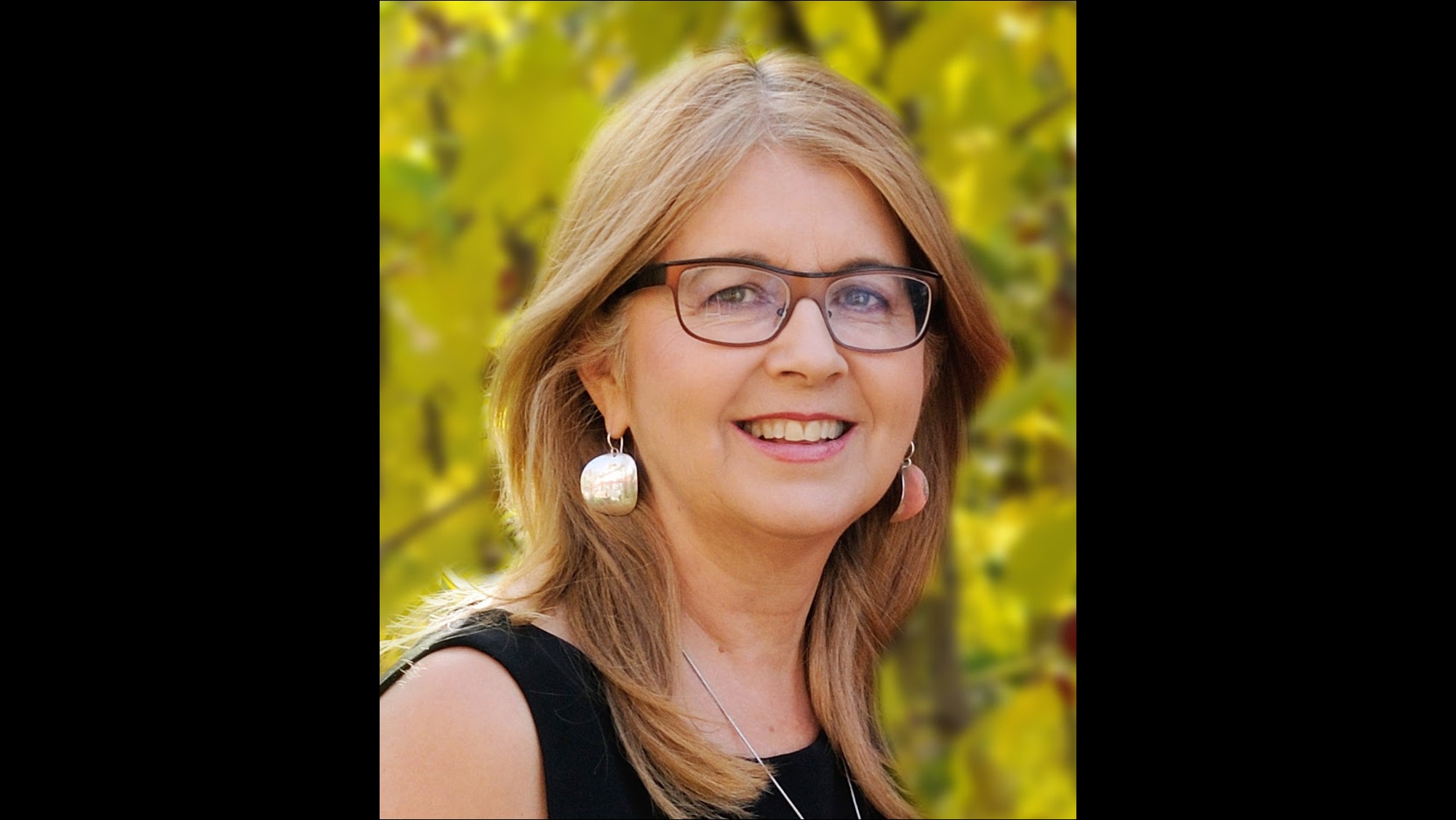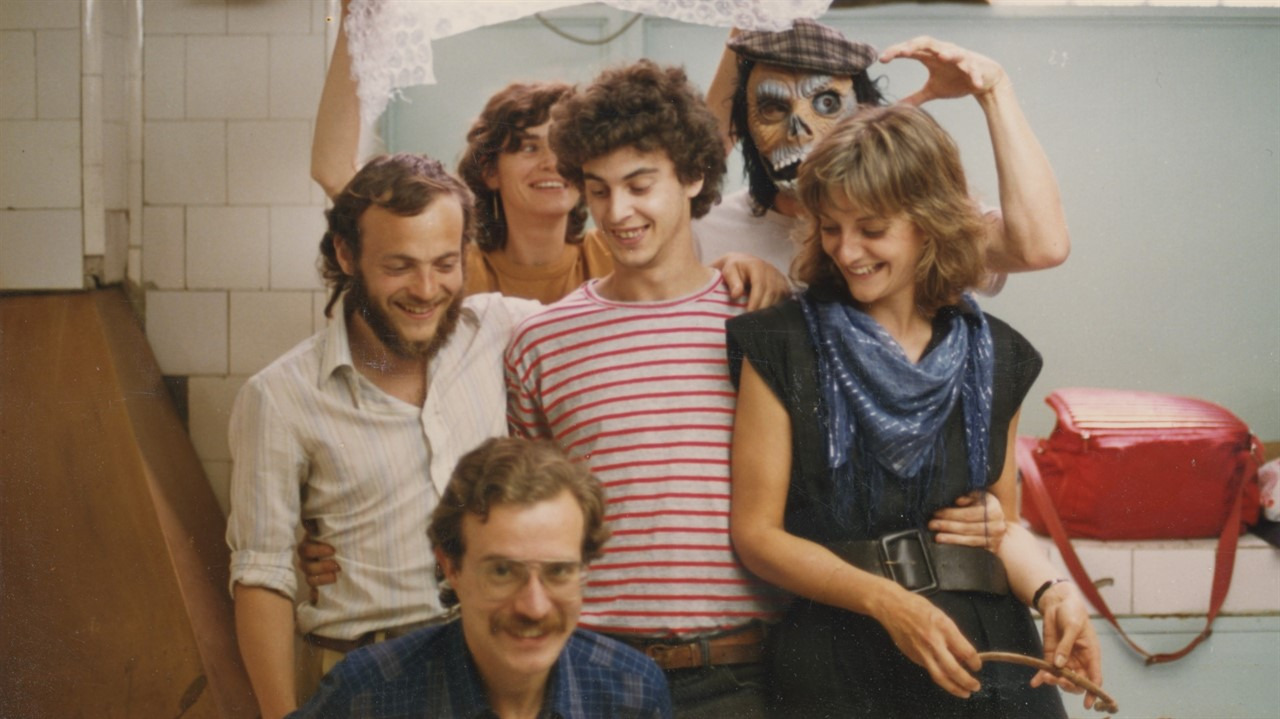If you don’t use it, you lose it. Megan Wennberg’s latest documentary Unsyncable, which premieres at this year’s Hot Docs festival–– celebrates a group of senior athletes as they form connections across borders, in and out of the pool. “Overall, it’s a story about aging,” explains Wennberg, director of Drag Kids (2019) and The Killing of Phillip Boudreau (2020). “But it’s also about finding a passion and doing it no matter how old you are.”
Unsyncable follows six senior artistic swimmers as they train for the 2022 US Masters Artistic Swimming Championships. It’s not lost on Wennberg that choreography is the building block of synchronized swimming. The film follows in these footsteps, arranging the many reasons that lead seniors to synchro into a wonderfully heartening formation –– all the while casting a critical eye on the stereotypes surrounding the sport.
Wennberg’s film debunks the ageism rooted in synchro and kicking back against the idea of one’s “golden years.” That said, audiences are also sure to discover the barriers faced by athletes as they candidly reveal their different, yet surprisingly intersecting experiences as they relate to racism, sexism, homophobia, and criminal justice.
POV sat down with Wennberg at her home in Dartmouth, Nova Scotia to speak about the doc ahead of the world premiere of Unsyncable.
Note: The following article contains mentions of discrimination based on race, gender, sexuality, and criminal records.
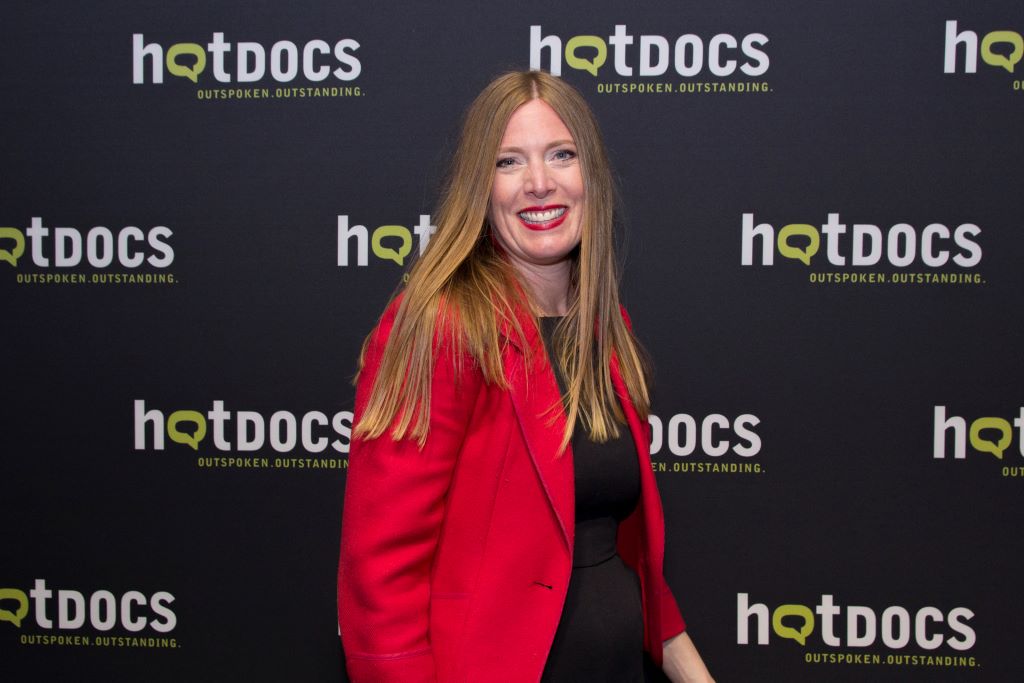
POV: Audrey Chan
MW: Megan Wennberg
This interview has been edited for brevity and clarity.
POV: Can you tell us a bit about how this doc came to be?
MW: Our production company (Tell Tale Productions) hired a researcher to find a list of Masters synchronized swimmers from all over North America. From there, I went through a big list of potential people and identified the ones I was most interested in talking to. Then I started calling them and having long conversations to figure out what drives them, and whether being in a doc is something they’re interested in because not everyone wants to be filmed, which I totally get. We were really lucky. With Cris [Meier-Windes] (a member of San Francisco’s Tsunami Aquatics, an LGBTQ+-friendly synchro team), I didn’t find him initially. I spoke to his coach Suzanne, who then suggested Cris. With world champion Sue [Baross Nesbitt], I’d spoken to someone on a different team, and then she let me know that Sue was back in the sport. All of it was a little circuitous.
POV: What drew you to making a film about synchronized swimming?
MW: The doc was funded at the very beginning of COVID. Filming started in December 2021 and production wrapped in October 2022. As the pandemic progressed, it seemed like the film was becoming more of an important story because it was about seniors taking charge of their own lives. They had this passion –– something they were really dedicated to –– that they were pursuing. And that was a story I really wanted to tell. I’ve always thought that synchronized swimming is so beautiful… and difficult! I love the visual aspects of it as well. Personally, I still haven’t tried doing synchro. I would like to do it, definitely. But, my God, it looks hard.
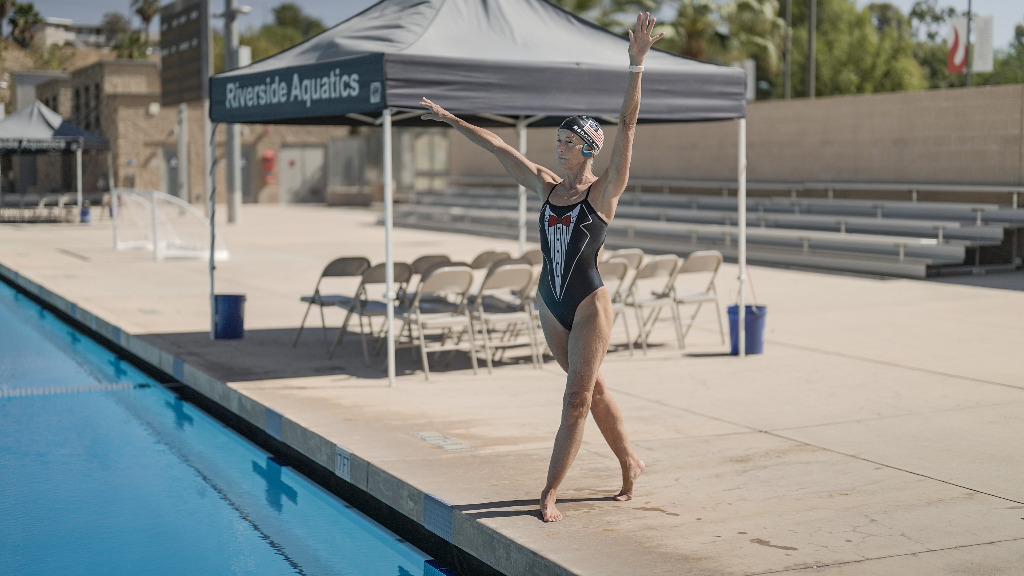
POV: I’m curious about what filming underwater was like.
MW: Being able to get in the water and do underwater cinematography was really exciting. My poor cinematographer Paul McCurdy hates the water, but he did a great job –– we were supposed to hire professional underwater cinematographers, but that didn’t work out. It fell on Paul’s shoulders to get in the water himself. He did a lot of it and I did some of it. We had a couple of other people that we met along the way who offered to help out, too. Our poster, which is shot from under these ladies in the water who are in the star formation, that shot was actually taken by the coach of that team because she was the only one who could hold her breath to get under there. None of us had the lung capacity of a single [synchronized] swimmer.
POV: Were there any other challenges that the pandemic posed for you and your team? I also wonder how COVID affected the sport, since you can’t mask in the water!
MW: We had gotten funding but we couldn’t start filming for a while because of the pandemic –– pools were closed and there were travel restrictions. It also affected the teams a lot. World synchro champion Sue [Baross Nesbitt] was the only one who was able to swim throughout the pandemic because the pools are outside in Southern California. She had good access, but the pools were closed for over a year for everyone else. So it definitely impacted the swimmers mentally, emotionally, and physically.
POV: You mention that filming was spaced out during the production. What was it like, building relationships with your characters in the interim?
MW: There was a lot of getting to know the swimmers before filming. Mainly it was in the conversations with them that the doc started to become clear to me. Seeing what Sue was able to do when we went down to Southern California was also an important moment. We had met her only 10 minutes before we shot her stretching on the pool deck, which is one of the first scenes of the doc. She’s lifting her leg up over her head and doing all these crazy things that I have never and will never be able to do. And what we didn’t get into in the film is that she coached for, like, 40 years. She was an elite athlete until her 20s, then she retired from synchro for 40 years, only to get back into it in her 60s because she wanted to use it as a way to prolong her life. She went right back to being the world champion.
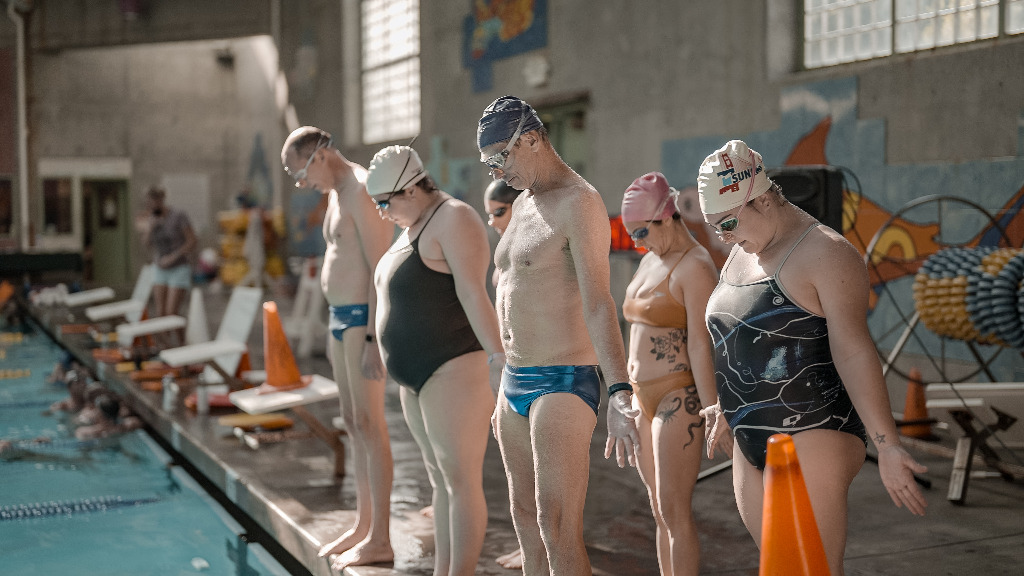
POV: There’s a moment in the film when Sue shows us all these archival documents from her earlier synchro days. How did it feel to discover all of that material?
MW: It was neat. Sue had to hunt for those for a bit because she’s a very humble person. A lot of her medals are in the back of her closet. You don’t even see trophies when you walk into her home. The other stuff is in the basement and she had to dig the photos out. It took a while to find the ones we were looking for, but she said something that really stuck with me. I asked her what it was like going through this stuff with people that she knows, but not that well, and she said, “It’s kind of like you’re going through my underwear drawer because it’s so personal!” It was shocking, though, when she was going through the photos and found the one of that creepy mayor who kissed her after her win. I was horrified. Sue said to me, “Oh, you have no idea how bad it was back then.” Nasty old dudes were just groping young girls left, right, and centre.
POV: Unsyncable touches upon the gendered history of synchro. Was this something you went into the doc wanting to explore?
MW: It was something about synchro I was definitely interested in. There are a lot of misconceptions around it because it’s primarily been women who participate in it. People don’t see it as a real sport because swimmers have to wear makeup and there’s meant to be smiling. There’s the idea that it’s easy, but really, it’s so difficult. Swimmers have had to fight a lot of stereotypes the whole way through. Being able to talk to people who’ve had to experience that, like Cris, offered a lot of insight. He would have loved to do synchro as a child but because he was a guy he wasn’t able to. It was only something he could come to later in life. So for him, it’s really exciting that synchro is finally opening up to people of different genders. If he was a kid now, he’d actually get to pursue this dream from the beginning, as opposed to finding it in his 50s.
POV: Was it your intention to find anecdotes that tie in so many experiences with stereotypes and discrimination within the sport (and beyond)?
MW: With Ellen, who couldn’t cross the border because of old records, the criminal justice one was a surprise. But yes, the other ones were intentional. There’s a lot of misconceptions around synchro, and there’s a lot of misconceptions around race, and aging, and gender. Synchro seemed like a really beautiful way to be able to explore that in a way where I wasn’t hitting people on the head with it. .Everyone’s connected authentically by their love of this sport, despite coming at it from such different backgrounds and hurdles. The extreme racism that the Harlem Honeys and Bears faced when they were growing up is crazy. And we didn’t even include all the stories. The Tsunami team was initially formed because gay athletes really didn’t have a safe space to swim at the beginning of the AIDS epidemic. People were wanting to drain pools after they were in them.
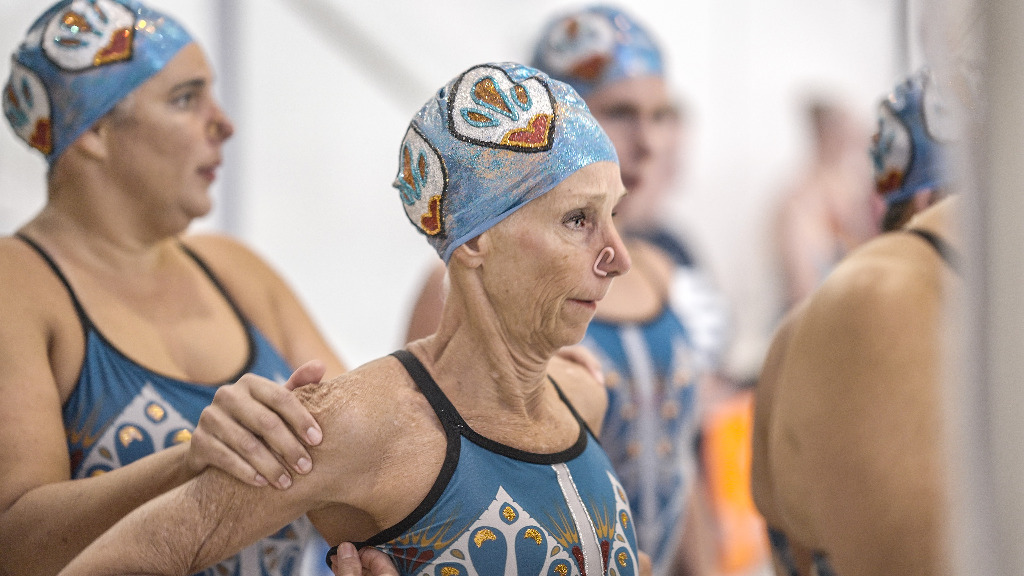
POV: How did following these characters shape your outlook on aging?
MW: I feel like the word “inspiring” is overused, but there’s definitely a little fire in me that goes, “Wow, these guys –– you wouldn’t guess their ages for most of them.” It really is just a number –– but it’s also more about an outlook on life. These swimmers have this thing that they’re passionate about, and they’re still pursuing it, and to really incredible degrees in a lot of cases. I hope I keep doing that –– whether it’s with making documentaries or whatever it is. Just staying really engaged with something that I love doing, and with other people who are, too.
POV: What was something that you learned while working on this film?
MW: To go with the flow. With documentaries, you get little reminders of that you can always make a plan, but it’s not necessarily going to happen exactly as you planned it because it’s real. People and circumstances change. And with this one, there were definitely a lot of things like that, whether it was a crew member getting COVID so we couldn’t continue on a trip, or Kitchener swimmer Ellen [Scott] not being able to go to Maine due to issues they had at the border. It’s all about trying to figure out how to adapt.
POV: Do you see parallels between synchro and working in documentary?
MW: Yeah, the teamwork part of it. It was interesting hearing from different people. For some swimmers, their teammates would drive them crazy sometimes. Or they might not agree on things or be in sync, but then they’d just keep working through it and they’d get this beautiful result at the end. It’s not something that’s possible with just one person. When it comes to filmmaking, it’s similar. For me and my crew –– especially the core members, like Paul McCurdy and Warren Jefferies, the editor, whom I’ve done my past three projects with and hope to keep working with –– it’s really the team that makes everything possible.
POV: How would you compare this production to previous ones you’ve worked on, like Drag Kids, for example?
MW: COVID definitely made Unsycnable a lot more challenging because we’ve never dealt with a pandemic before, but it also gave me an opportunity to get to know people better before we started filming with them because production kept getting pushed off by months. It was really nice to be able to tell a positive, hopeful story during a pretty dark time as well. It reminds me of Drag Kids in that both docs are about people with a niche interest, but they’re still about finding community and what it is about the passions that they love.
POV: Are there any other niche interests you might be interested in covering with future projects?
MW: Yeah! Producer Theresa McKinnis and I just got greenlit for CBC’s The Nature of Things. I love the natural world and anything about animals, so that’s going to be fantastic. It’s on whooping cranes, so it’s super specific. They’re a bit of an extinction success story. We’re going to be following them throughout North America, and then also the eastern sarus crane in Thailand and Vietnam. So we’re gonna get to go there, where I’ve never been. I’m so, so excited.
POV: What do you want audiences to walk away from Unsyncable feeling?
MW: I really hope that people walk away feeling uplifted by the story, and especially by the characters because they’re so amazing to spend time with. I hope that regardless of whether they’d be interested in trying synchro swimming, they feel that it’s never too late to try something that they want to do, or to keep doing something that that they’re passionate about.
Unsyncable premieres at Hot Docs 2023.
Get more coverage from this year’s festival here.
Update (14/10/2023): Unsynacable is now on TVO and streams on Vision TV until Nov. 7.




